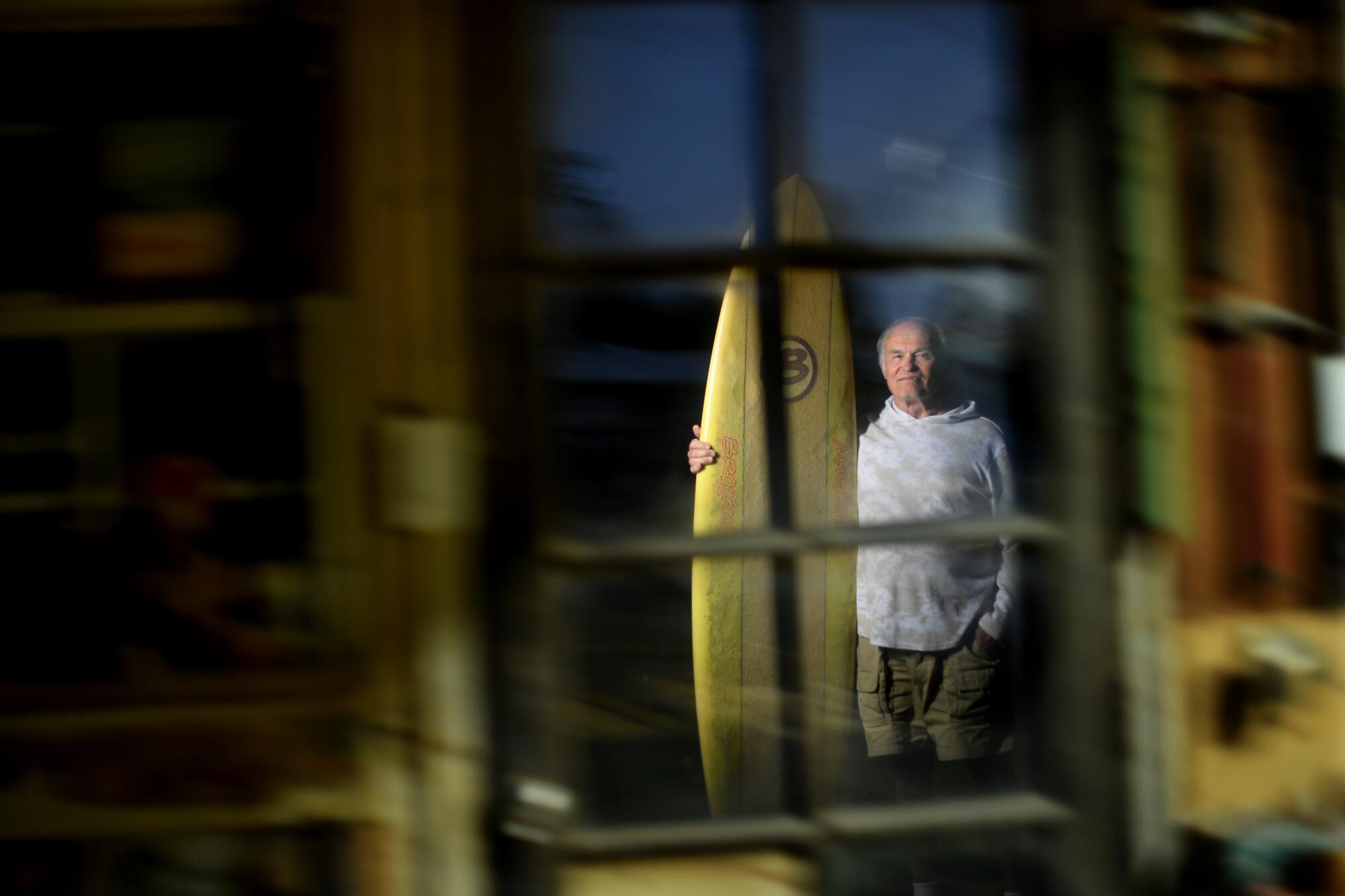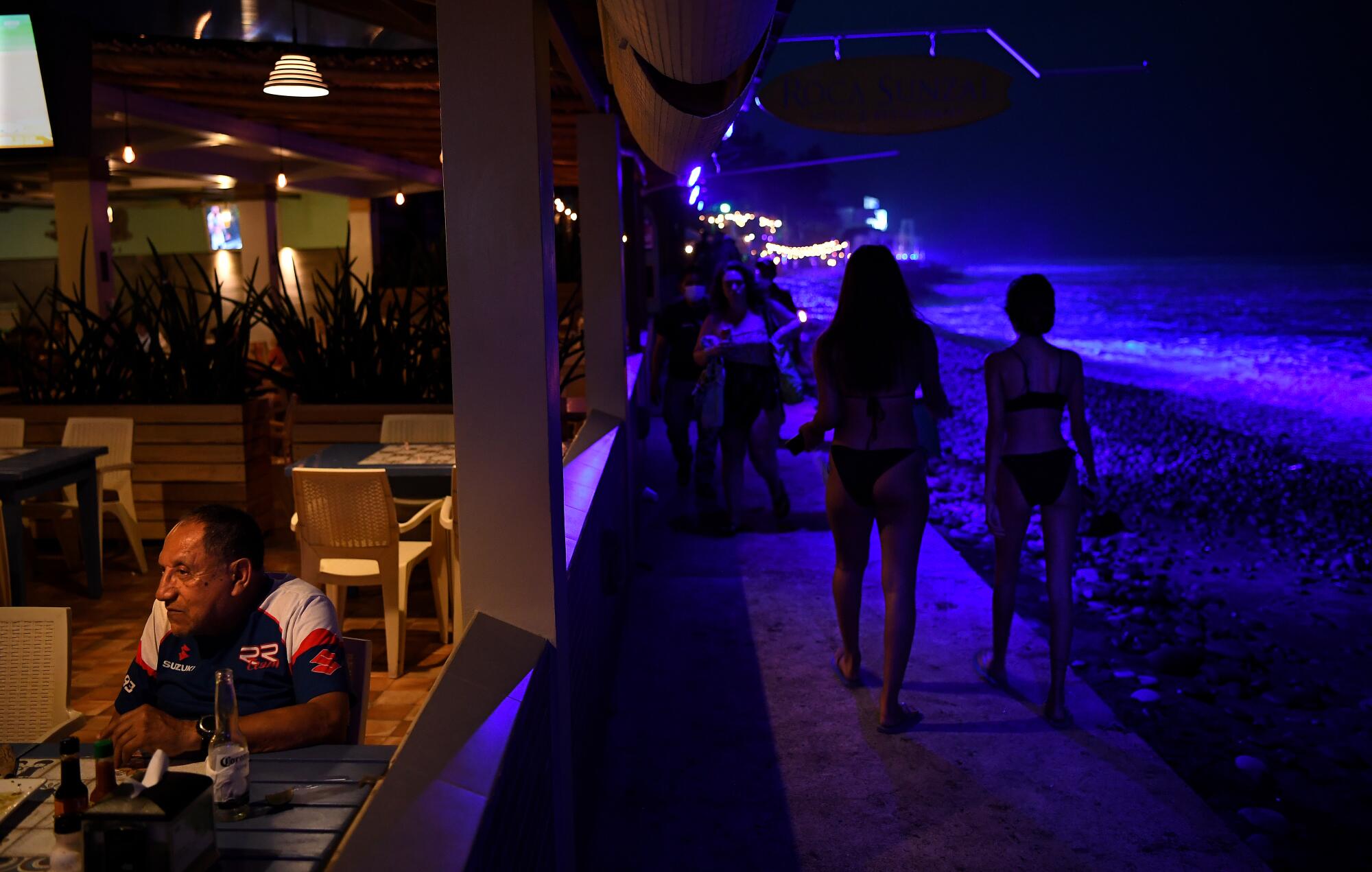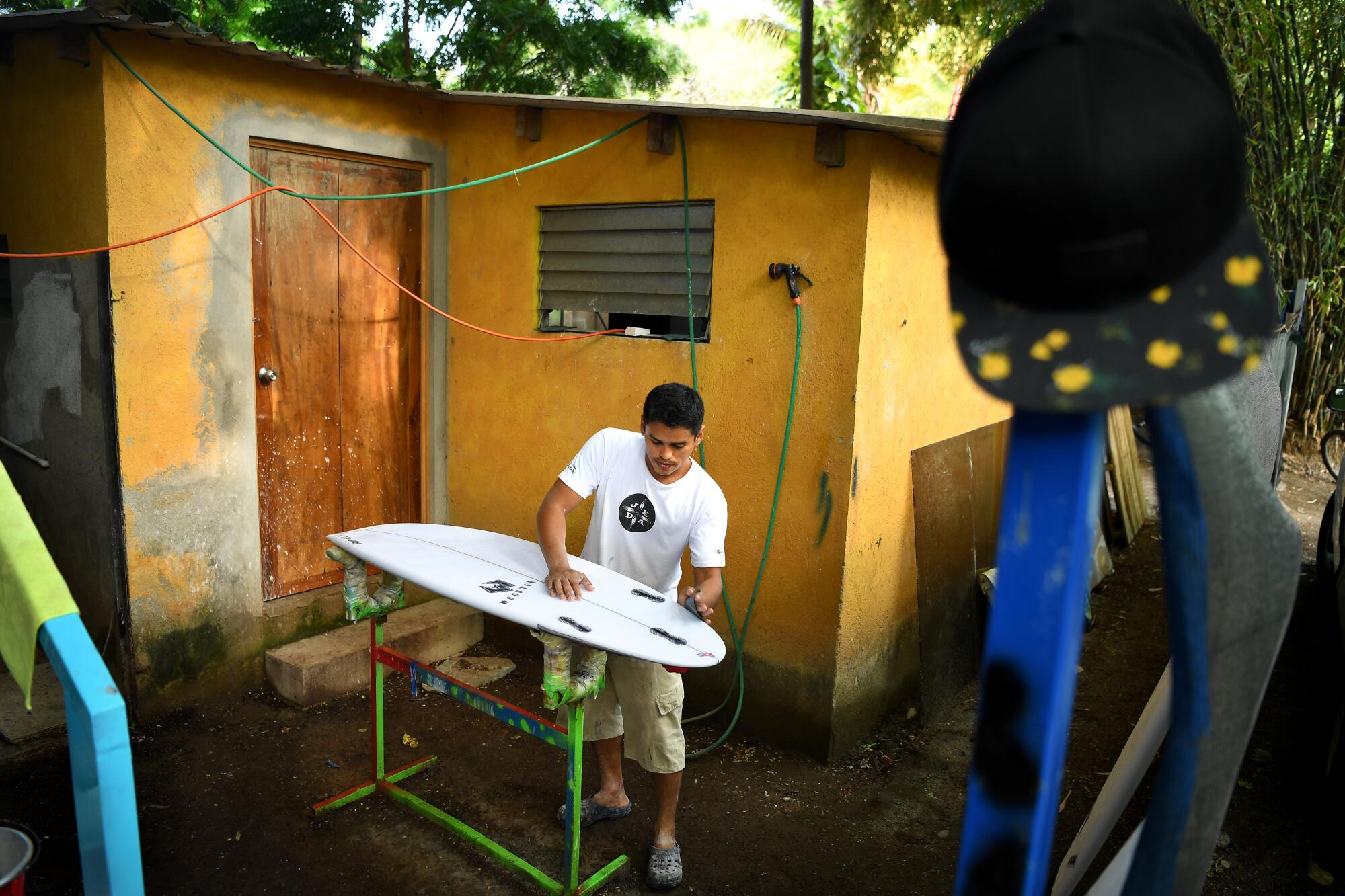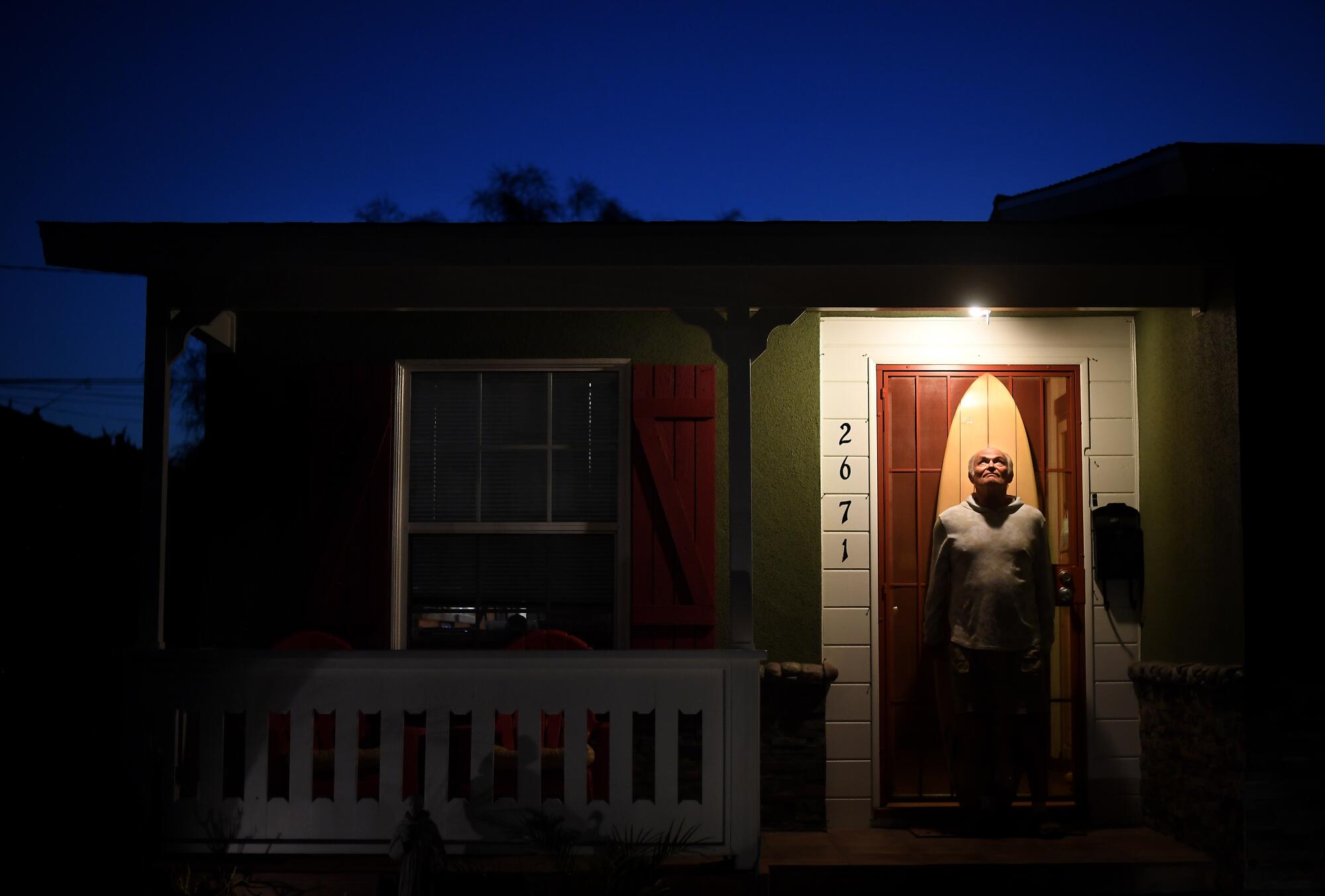
- Share via
LA LIBERTAD, El Salvador — Bob Levy grew up in El Salvador but discovered surfing in California, and he vividly remembers the day he returned to his homeland and hit the beach with a stiff, 10-foot surfboard under his arm.
“They didn’t even know it was a board,” Levy recalled. “They thought it was an airplane wing.”
Decades later that wing, along with a prayer of sorts from the government, has turned a 13-mile stretch of Salvadoran shoreline into one of the world’s newest surfing meccas. It’s a spot where the waves are so ripe and the water so warm, tourism officials are hoping it can repair the country’s battered image while the International Surfing Assn. has chosen it as the location of the final qualifying rounds for the debut of surfing as an Olympic sport this summer.
The eight-day competition, known as the World Surfing Games and featuring 256 athletes from 51 countries, concludes Sunday.
But it might never have happened had Levy and two Huntington Beach teenagers he met there kept the secret of Salvadoran surfing to themselves.
“When I heard they were going to have the Olympics tryouts, I was shocked,” said Levy, a semi-retired carpenter living in Long Beach. “I thought, ‘Oh, my God, we made history.’ El Salvador’s got a lot of really, really good surfers now.”
Levy, 75, was the first. And the story of how he got there involves an Oxford-educated veterinarian, a beach visit the summer he graduated high school and a creaky Volkswagen van he and friends often had to push from the Texas border to the Salvadoran shore.
It starts with Levy’s father Robert, the veterinarian, who was on his way to treat cattle in the Argentine pampas when he detoured to El Salvador to help some relatives open a general store. He soon married a Salvadoran woman, started a family and never left.
But Bob did. After his father died, he and his mother moved to Northern California, where a chance encounter with surfing changed his life.
“Once I put my foot in the water I was hooked,” he said. “I’ve been surfing ever since.”
A lot of other people also were hooked, which made the lineups to catch a wave in California and Baja Mexico frustratingly long. So Levy packed up the van and headed home to El Salvador in search of the open waves he remembered from childhood trips to the shore.
“I just thought, you know, what a great little getaway place,” he said. “Back in the mid-’70s people were just itching to get the hell out of whatever country they were from. And that’s how surfing pretty much [was].”

He was soon joined by Kevin Naughton and Craig Peterson, who had left Orange County and headed south on a surfing safari of their own. What they found when they reached El Sunzal was a beach that was both perfect and deserted, save for Levy and a few friends.
“You knew every single person in the water,” Naughton said. “There was never more than five or six people out anywhere.”
There wasn’t even a hotel or restaurant nearby, so the surfers rented a tiny house and paid a local woman to cook for them.
“I don’t think you could get any more of the little idyllic, bucolic town. It was all quiet,” Naughton said. “It was a different mentality then. The whole point was to find a spot and keep it a secret.”
Turns out Naughton and Peterson weren’t very good at that last part, with Naughton writing a couple of articles for Surfer magazine that Peterson illustrated. They never pinpointed their location — referring only to beaches south of Mexico — but other surfers figured it out and the crowds, like the waves, began to swell.
“There was already traffic started,” Levy said. “How it got started, I’m not really sure. Probably reading [those] articles.”
It was the early 1970s and El Salvador was known primarily for coffee, sugar and staggering economic inequality that eventually sparked a revolution. But the surfers were drawn by the narrow, rocky beaches and the spectacular point-break waves, which break to the surfer’s right and are more consistent than the sandy-bottom beach-break waves common in California.
Soon Levy opened a small shop to feed the demands of a growing band of surfers, driving back and forth to California to gather boards and other surf paraphernalia. On one trip his Volkswagen, a 1964 Westfalia, stopped running as soon as he crossed into Matamoros, Mexico.
“Something happened to the alternator, right on the first leg of the trip, so we ended up pushing the van all the way to El Salvador,” he said. “We would push it and then it would start and we’d drive.”

Bob Rotherham, a teacher and surf photographer from Florida, also was part of that first wave.
“When I showed up they tried to get rid of us,” Rotherham said of local authorities. “They sent teams from immigration to roust up the long-haired hippie surfers that were bringing all these bad habits to the salvadoreños.”
But unlike the others, he never left. After falling in love with a local girl named Marta, Rotherham, who now answered to Roberto instead of Bob, bought some beachfront property from Levy’s family and placed a huge bet that the crowds would continue, opening a restaurant and hotel — soon to be two — just yards from the water.
That plan was interrupted in 1979 when a failed coup led to a civil war that lasted more than a dozen years, killing an estimated 80,000 people and causing as many as 1 million more to flee their homes, many of them settling in Southern California.
“We had some close calls during the war. But it was just, I was at the wrong spot at the right time,” Rotherham said.

Rotherham rode out the bad times like a giant wave. His second surf resort, Punta Roca, became one of the most popular in the area, and his son Jimmy a Salvadoran surfing champion.
“Everyone down there models their surfing after Jimmy,” Levy said.
Naughton and Peterson found more adventure farther south, continuing on to test the waters off Costa Rica. They soon caught the attention of police, who arrested the young hippies just outside the town of Jacó on trumped-up charges of running an ice cream truck off the road.
“We were actually hippies in training,” corrected Naughton, 68, who ran a nursery in Laguna Beach for 35 years. “And we saw no ice cream trucks in Costa Rica. But we would have hijacked one if given the opportunity.”
They spent two days in custody, playing Frisbee and sharing old Playboy magazines with their jailers, before the police realized the two Americans accepted their incarceration because they didn’t have enough money to feed themselves on the outside.
“We were just freeloading,” said Naughton, who still surfs regularly with Peterson, a 65-year-old digital marketing manager from Dana Point. “After a couple of days they just said, ‘Get out of here, you bums.’”
Jacó later erected a statue of a surfer, a board under his arm, in the town square, a nod to the nearly $800 million the sport annually contributes to the Costa Rican economy.

That’s the kind of return El Salvador is looking for with Surf City, the English-language name it has given to both the location of the country’s best beaches in the department of La Libertad and the ambitious five-year project to develop them.
“Everywhere there’s a good, rideable wave there’s resorts and hotels,” said Rotherham, 71, the only one of the original gang of four who still surfs Salvadoran waters. “The surfer tourists are losing their fear of coming to El Salvador. Surfing has become mainstream everywhere. In the old days we were the rats they wanted to get rid of.”
The government, which has sought outside investors, has been vague about the price tag but estimates construction of roads, bike paths and infrastructure improvements to piers and water systems will cost more than $300 million.
Morena Valdez, the minister of tourism, says she expects that will support more than 200 businesses as the country recovers from the COVID-19 pandemic, which decimated the tourist sector.
Before the coronavirus, Valdez said, the government had projected Surf City, about 20 miles from the capital of San Salvador, would create 50,000 direct jobs and indirectly support 300,000 more.
“The main purpose is to make El Salvador a good destination to visit, invest and live,” Valdez said.
Salvadoran officials hope it will also change perceptions of a country that recently ranked as the deadliest in the world without a war within its borders. In the two years since President Nayib Bukele was elected and made Surf City a major focus of his administration, El Salvador has had the number of homicides fall to the lowest rate in more than two decades.
“Surfing definitely changes lives. That’s something we see in El Salvador as well as other countries,” Valdez said.

Fernando Aguerre, president of the International Surfing Assn., agrees, which may be one reason why the ISA chose El Salvador over Japan, Australia, Costa Rica and Spain for the right to host this week’s qualifiers for the Games in Tokyo.
“When a surf spot gets developed, that creates an interest to travel to that destination. So this is like a win-win, no?” Aguerre said. “This could be a before and after. If those things happen to change perceptions, that’s a big deal.”
To witness that change he had to look no further than the blue-green waters off La Bocana and El Sunzal, which teemed Monday with dozens of surfers from countries ranging from Turkey, Iran and Israel to Senegal, Switzerland and Ukraine. Posters touting Surf City beneath a stylized wave in the blue and white of the Salvadoran flag dot the highway between the capital and the beaches, alongside signs that warn drivers to “slow down, surfers are on the highway.”
Three days into the competition workers still were putting fresh coats of paint on sparkling new hotels, restaurants and shops that have sprung up next to tiny wooden shanties with roosters in the yards.
Salvador Castellanos, a popular TV news anchor, saw the potential even before the government and the ISA did, starting the faith-based program Surfing Missions 15 years ago to offer an alternative to the MS-13 and 18th Street gangs, which he said engage in extortion and drug sales along El Salvador’s coast.
Much of that has stopped since Surf City was launched, he said.
“They are present in the communities but do not engage in criminal activity, probably because their relatives are part of the local economy and see tourism as a source of income,” Castellanos said of the gangs. He called it a “virtuous circle which includes generating opportunities, stimulating the economy, improving everyone’s income, attracting tourism.”
One of the people Castellanos’ program reformed is Bryan Pérez, who lost friends, as well as his 2-year-old sister, to gang violence. He’s now a Salvadoran national surfing champion whose dreams of competing in the Tokyo Games came up just short in the Olympic qualifier.
“It is part of a holistic system of transformative development,” Castellanos said. “It is not just surfing. Also education, mental health, spirituality. It all produces a positive effect.”
Yet the people who started it all by bringing surfing to El Salvador never saw the potential.
“The original crew, we’re all still buddies and we stay in touch,” Naughton said. “And none of us could foresee that it was going to go the way it went. There were no fortune tellers or prophets in flip-flops to tell everybody ‘here’s now it going to be in 30, 40 years.’ Nobody could see that surfing would go through the transformation that it’s gone through.”

Levy, meanwhile, hasn’t changed at all. The man some call the Godfather of Surfing in El Salvador still rides the waves regularly with his daughter despite two knee replacements and three heart attacks — all of which happened while he was in the water. But while he remains a Salvadoran citizen, he hasn’t been back to El Sunzal since 2013.
The empty waters that once beckoned him, he says, are too crowded now.
Can he take credit for starting Salvadoran surf culture? He answered with a shrug. “I don’t think so,” he said. “But was I the first? I’m pretty sure yes. That’s all I can take claim for — not that I even want to claim that. To me, it was just like I said it was: a little sanctuary.”
One the world now has discovered.
More to Read
Go beyond the scoreboard
Get the latest on L.A.'s teams in the daily Sports Report newsletter.
You may occasionally receive promotional content from the Los Angeles Times.









